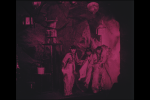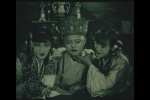 The only known surviving copy of a classic 1927 Chinese silent film has returned home. The restored copy of Pan Si Dong (The Cave of the Silken Web) was handed over to the China Film Archive in Beijing on Tuesday. After the ceremony and a reception attended by invited guests, the film, accompanied live by Chinese pianist Jin Ye, was screened at a sold out show in front of an audience of 600.
The only known surviving copy of a classic 1927 Chinese silent film has returned home. The restored copy of Pan Si Dong (The Cave of the Silken Web) was handed over to the China Film Archive in Beijing on Tuesday. After the ceremony and a reception attended by invited guests, the film, accompanied live by Chinese pianist Jin Ye, was screened at a sold out show in front of an audience of 600.
 The film was thought to be lost until a nitrate print from 1929 was discovered in the National Library of Norway. It was found in 2011 when the library decided to examine all 9,000 cans of film in its collection. At first they didn’t realize what a treasure they had. The film had no opening credits to easily identify it and it was too delicate for careful examination of the whole movie. After an initial cleaning, the nitrate film was sent to a laboratory where it was copied onto stock that does not spontaneously burst into flames. Library researchers then began to investigate the history of the movie. That’s when they discovered that they had the only existing copy in the world.
The film was thought to be lost until a nitrate print from 1929 was discovered in the National Library of Norway. It was found in 2011 when the library decided to examine all 9,000 cans of film in its collection. At first they didn’t realize what a treasure they had. The film had no opening credits to easily identify it and it was too delicate for careful examination of the whole movie. After an initial cleaning, the nitrate film was sent to a laboratory where it was copied onto stock that does not spontaneously burst into flames. Library researchers then began to investigate the history of the movie. That’s when they discovered that they had the only existing copy in the world.
 Pan Si Dong, directed by Dan Duyu for the Shanghai Shadow Play company, tells a story taken from Journey to the West, a 16th century book by Wu Cheng’en that is considered one of China’s four classic novels. The hero is Hiuen Tsiang Tang, a Buddist monk sent to the “Western regions,” ie, India, by Emperor T’ai Tsung to bring back sacred texts. Accompanied by three protectors — Monkey, Pigsy and Sandy — and riding a fourth companion, the Dragon prince, in the guise of white horse, the monk arrives at the spider valley where they find themselves in a cave where seven beautiful women live.
Pan Si Dong, directed by Dan Duyu for the Shanghai Shadow Play company, tells a story taken from Journey to the West, a 16th century book by Wu Cheng’en that is considered one of China’s four classic novels. The hero is Hiuen Tsiang Tang, a Buddist monk sent to the “Western regions,” ie, India, by Emperor T’ai Tsung to bring back sacred texts. Accompanied by three protectors — Monkey, Pigsy and Sandy — and riding a fourth companion, the Dragon prince, in the guise of white horse, the monk arrives at the spider valley where they find themselves in a cave where seven beautiful women live.
 The women are actually spider spirits in disguise who want to devour the monk, believing this will make them immortal. They succeed in capturing the party, but then one of the spider spirits is busted trying to double-cross the rest so she and her demon lover can eat him on their own. In the ensuing battle, Xuanzang and his spirit compadres escape. The spider women and their webs are destroyed by purifying fire.
The women are actually spider spirits in disguise who want to devour the monk, believing this will make them immortal. They succeed in capturing the party, but then one of the spider spirits is busted trying to double-cross the rest so she and her demon lover can eat him on their own. In the ensuing battle, Xuanzang and his spirit compadres escape. The spider women and their webs are destroyed by purifying fire.
 The movie was hugely popular in China and a sequel was made in 1929. While the sequel was playing in China, the original made its way to Norway. Pan Si Dong was the first Chinese picture to be shown in Norway. It premiered in Oslo’s Chat Noir Cabaret Theater on January 18th, 1929, accompanied by the Colosseum orchestra. The print was customized for Norwegian audiences, with Norwegian translations appearing alongside the original Chinese on the title slides. The translation is not always accurate to the original. The translator interspersed his own comments in brackets next to some titles, and the Chinese is sometimes upside-down or backwards. This was noticed in some of the contemporary reviews which were generally positive, if patronizing. Norwegian reviewers found it “distinctive and interesting,” “quite strange,” and “worthwhile as a curiosity.”
The movie was hugely popular in China and a sequel was made in 1929. While the sequel was playing in China, the original made its way to Norway. Pan Si Dong was the first Chinese picture to be shown in Norway. It premiered in Oslo’s Chat Noir Cabaret Theater on January 18th, 1929, accompanied by the Colosseum orchestra. The print was customized for Norwegian audiences, with Norwegian translations appearing alongside the original Chinese on the title slides. The translation is not always accurate to the original. The translator interspersed his own comments in brackets next to some titles, and the Chinese is sometimes upside-down or backwards. This was noticed in some of the contemporary reviews which were generally positive, if patronizing. Norwegian reviewers found it “distinctive and interesting,” “quite strange,” and “worthwhile as a curiosity.”
 Side note of interest: one of the great things about silent movies is how universal they were. Movie theaters all over the world could easily created title cards in their language. There was no need for post-production translations of complex dialogue and dubbing. That means it really doesn’t matter where a lost silent picture is found, because the movie retains its integrity even when the title card translations are tonally questionable or inaccurate.
Side note of interest: one of the great things about silent movies is how universal they were. Movie theaters all over the world could easily created title cards in their language. There was no need for post-production translations of complex dialogue and dubbing. That means it really doesn’t matter where a lost silent picture is found, because the movie retains its integrity even when the title card translations are tonally questionable or inaccurate.
Movies from this period are rare survivals in China, thanks to censorship, war and after 1949, the Communist rejection of Western and traditional Chinese arts. Since the revival of Chinese cinema in the 1990s and the loosening up of markets, China is as keen to retrieve its lost cinematic patrimony as it is its dispersed antiquities. Diplomatic relations between China and Norway have been tense since 2010 when the Nobel Committee gave the Peace Prize to democracy activist Liu Xiaobo, currently serving an 11-year prison sentence for his political writings. Last fall Norway agreed to return seven marble columns looted from the Old Summer Palace, and now they’ve restored and returned Pan Si Dong.